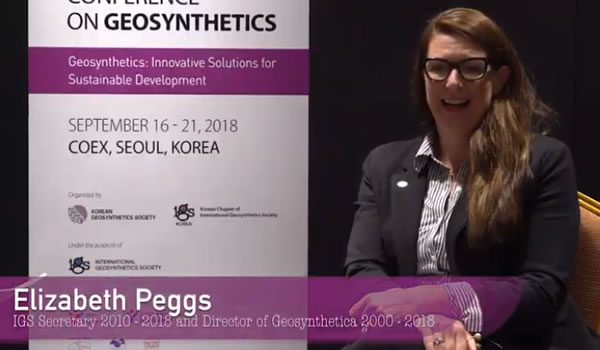At the 11th International Conference on Geosynthetics (September 2018, Seoul), the International Geosynthetics Society recorded another “Two for a Few” interviews, which brings together leaders in the field for a brief talk. This time around, the IGS chose a departing member as the subject: Elizabeth Peggs.
Peggs had served as IGS Secretary for 8 years and spent nearly 20 years in geosynthetics. Earlier in 2018, she announced that she was stepping away to reduce her travel obligations and take up a new career challenge.
Dr. Laura Carbone sat down with Peggs for the 17:00-minute conversation.
Dr. Carbone opens with a question on how Elizabeth Peggs entered the field. Her origin story (to borrow the parlance of superhero lore) is also Geosynthetica’s. Dr. Ian Peggs (Elizabeth’s father-in-law) was concerned with failures on project sites at a time when the geosynthetics industry seemed poised to grow significantly. The problem, Dr. Peggs concluded, was a lack of open information sharing. Elizabeth had a marketing and communications career. Dr. Peggs asked her if she felt a website venture would be a way to resolve some of the field’s education and outreach needs.
Elizabeth seized the opportunity, leaving her previous career and taking on the challenge of fully pushing the fledgling Geosynthetica operation outward. The end result has been hundreds of thousands of readers and many millions of pages and documents shared over the years.
Geosynthetica, which emerged out of the former print newsletter Industry Insight, will celebrate its 20th anniversary in 2019.
“The work at IGS, the work at Geosynthetica, the work at Minerva I’ve done, all of it addresses the same issue: communication,” Elizabeth Peggs says. “There’s such a huge body of great work in this industry, and without communication it just doesn’t get to the people who can leverage that to do great things.”
One of the earliest and clearest signs for the need of greater communication endeavors in the geosynthetics fields came when she attended an engineering conference and found that a great many attendees did not recognize even generic “geo” language. They had the application need, but not awareness of the engineered materials options.
“You have to tell your story. You have to communicate your technology,” she says.
RELATED: 11 ICG Was an Enormous Success for Geosynthetics
ELIZABETH PEGGS ADVICE FOR YOUNG PROFESSIONALS
Dr. Carbone, who chairs the IGS Young Members Committee, asked Peggs on what young professionals might do to grow in this profession.
Peggs’ advice is simple:
- Attend IGS events
- Contribute papers
- Tell the story
“Jump into the community,” Peggs says. “Be a part of it. … Don’t be intimidated by [veteran] members of your community.”

“Look for opportunities to apply your solutions in novel ways,” she adds. “Just because it hasn’t been done before doesn’t mean it can’t be done moving forward. There’s an enormous amount of support when folks are interested in coming up with creative solutions.”
THE TAKEAWAY
So what is a key moment or anecdote Elizabeth Peggs will take with her?
“I’m not sure it’s the most fun, but there is something poignant,” she says. “I didn’t really realize the impact t the time it happened.”
She references a GRI event in Las Vegas, one of the first geosynthetics events she attended.
“There was this guy wearing a black leather vest,” she said. “Didn’t fit in. Dean Sandri.”
Sandri, who was curious about how Geosynthetica would help the field, had a simple message for Peggs: communication wasn’t the only problem with geosynthetics; the industry, as presented, just wasn’t “sexy.”
(Years later, Sandri served as President of IGS North America and partnered with Elizabeth Peggs and Minerva on running GeoAmericas 2016, which is to date the most successful installment of the Americas regional geosynthetics conferences.)
The challenge of telling these stories came back years later when Peggs attended a manufacturing event about how EVOH layers were now going to be available for gas barrier enhancement in geomembranes. It was a technology, she says, that wasn’t originally developed for civil engineering. It was, in fact, technology that was advanced by searching for how to retain air bubbles in athletic shoes for cushioning and lightness.
“Tennis shoes are sexy,” Peggs said. “They got millions of dollars to solve a problem.”
It took decades, though, to get support and research to show how EVOH could be used as a powerful gas barrier, such as to prevent VOCs from impacting the environment.
“Sometimes there’s a perception that marketing is beneath [engineers and academics],” she says. “Or, marketing is dirty. It’s not. It’s our job to market ourselves. We’re doing good stuff. The world needs to know we’re doing good stuff.”
Learn more about the International Geosynthetics Society at www.geosyntheticssociety.org.











